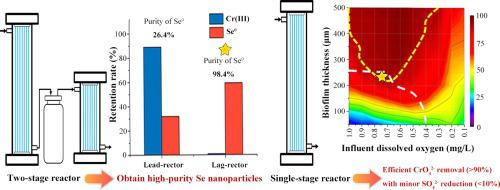Environment International ( IF 10.3 ) Pub Date : 2021-10-07 , DOI: 10.1016/j.envint.2021.106925 Zhen Wang 1 , Xueming Chen 2 , He-Ping Zhao 1

|
Selenate (SeO42−) and sulfate (SO42−) are frequently present together with chromate (CrO42−) in certain industrial wastewaters. SeO42− and CrO42− are required to be reduced while SO42− reduction should be minimized to avoid the production of toxic sulfide. In this study, a modified biofilm model was employed to investigate the interactions between CrO42−, SeO42− and SO42− bioreduction in a methane (CH4)-based membrane biofilm reactor (MBfR). The model was calibrated using steady-state experimental data of two reported CH4-based MBfRs reducing these oxyanions. The modeling results suggested that the majority of methanotrophs (>80%) were located in the outer layer of the biofilm, while the oxyanions-reducing bacteria preferred to grow close to the membrane. The introduction of SeO42− or SO42− enriched selenate/sulfate-reducing bacteria (SeRB/SRB) but decreased the abundance of chromate-reducing bacteria (CRB). A biofilm thickness of >300 μm, an HRT of higher than 4 h and an influent dissolved oxygen concentration of 0.3 mg /L were favorable for simultaneous high-level CrO42− and SeO42− removal. A two-stage MBfR system with optimized operational conditions showed promise in retaining high-purity (>98%) selenium nanoparticles when treating both CrO42− and SeO42− impacted wastewaters. Moreover, the model indicated that efficient CrO42− removal (>90%) along with minor SO42− reduction (<10%) could be realized via maintaining appropriate biofilm thickness (200-250 μm) and influent dissolved oxygen (0.7–0.8 mg /L) in a single MBfR. These findings offer insights for the design and operation of CH4-based technology for remediating CrO42− contaminated industrial wastewaters.
中文翻译:

基于模型的甲烷膜生物膜反应器中铬酸盐、硒酸盐和硫酸盐还原的分析
在某些工业废水中,硒酸盐 (SeO 4 2- ) 和硫酸盐 (SO 4 2- ) 经常与铬酸盐 (CrO 4 2- )一起存在。SeO 4 2-和CrO 4 2-需要被还原,而SO 4 2- 的还原应尽量减少以避免产生有毒的硫化物。在这项研究中,经修饰的生物膜模型,用于研究的CrO之间的相互作用4 2-,SEO 4 2-和SO 4 2-中甲烷生物还原(CH 4) 为基础的膜生物膜反应器 (MBfR)。使用两个报告的减少这些氧阴离子的基于CH 4的 MBfR 的稳态实验数据校准该模型。建模结果表明,大多数甲烷氧化菌 (>80%) 位于生物膜的外层,而氧阴离子还原菌更喜欢在膜附近生长。引入SeO 4 2-或 SO 4 2-富硒酸盐/硫酸盐还原菌 (SeRB/SRB) 但降低了铬酸盐还原菌 (CRB) 的丰度。大于 300 μm 的生物膜厚度、高于 4 h 的 HRT 和 0.3 mg /L 的进水溶解氧浓度有利于同时高水平 CrO 4 2-和 SeO4 2−去除。具有优化操作条件的两级 MBfR 系统在处理受 CrO 4 2-和 SeO 4 2-影响的废水时,有望保留高纯度 (>98%) 的硒纳米颗粒。此外,该模型表明,有效的CrO 4 2-轻微SO沿去除(> 90%)4 2-减少(<10%)可能被通过保持适当的生物膜的厚度(200-250微米)和进水溶解氧实现(0.7 –0.8 mg /L)在单个 MBfR 中。这些发现为基于CH 4的技术用于修复 CrO 4 2-污染的工业废水的设计和操作提供了见解。











































 京公网安备 11010802027423号
京公网安备 11010802027423号